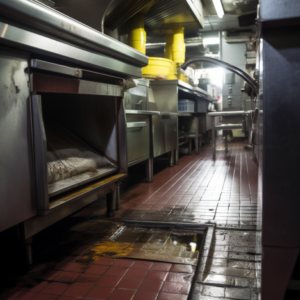When it comes to the bustling world of restaurants, cafés and commercial kitchens, grease traps are working behind the scenes. They are an important component in the smooth operation of these culinary spaces.
A grease trap prevents the culinary aftermath from wreaking havoc on plumbing and the environment. Let’s talk about grease trap installation in O’Fallon, MO, and the nitty-gritty details of these commercial marvels.
What Does the Grease Trap Do?
Before we get into the installation process let’s take a moment to appreciate the grease trap’s role. It’s like the custodian of your plumbing system. It captures fats, oils, and grease before they enter the sewer lines. By doing so, it prevents clogs, backups, and environmental pollution. This makes it an important part of any commercial kitchen.
The First Steps
The first step in installation is to determine the needs of your commercial kitchen. The size and type of grease trap required depend on the kitchen’s capacity and the local regulations. For instance, a small café will require a different setup compared to a bustling restaurant.
Location, location, location! Deciding where to place the grease trap is very important. It should be easily accessible for maintenance yet strategically located to capture messes efficiently. This can sometimes involve digging into the kitchen floor to create a pit for the grease trap.
Next, it’s time to connect the grease trap to the plumbing system. This is where the magic happens. The trap intercepts the wastewater, allowing waste to separate and settle while the cleaner water continues its journey to the sewer.
Choosing the Right Grease Trap
Commercial kitchens have various options when it comes to grease traps. From gravity grease traps to automatic ones. The choice depends on the kitchen’s needs, the volume of business, and local regulations. Selecting the right trap helps for efficient operation.
The size of your grease trap should be adequate to handle your kitchen’s output without frequent cleanouts. An expert can calculate the ideal size based on your kitchen’s requirements. Before installation, be aware of local regulations and permitting requirements. Compliance is important to avoid future complications and fines.
Maintenance
Once your grease trap is installed regular maintenance is a must. This involves routine cleanouts and inspections to ensure the trap continues to function well. Neglecting maintenance can lead to unpleasant plumbing issues and even compliance violations.
Installing a grease trap isn’t just about protecting your plumbing. It’s also about being environmentally responsible. By preventing food waste from entering the sewer system, you’re contributing to cleaner water and a healthier ecosystem.
In the high-octane world of commercial kitchens, where the sizzle and aroma take center stage, it’s easy to overlook the humble grease trap. Yet it allows for the smooth flow of operations. The installation of a commercial grease trap is a process with attention to detail being the key–from sizing and location to maintenance and environmental responsibility. So, next time you dine at your favorite eatery, remember that behind every delicious dish, there’s a grease trap at work.
Contact Performance Plumbing today to schedule your installation appointment!

